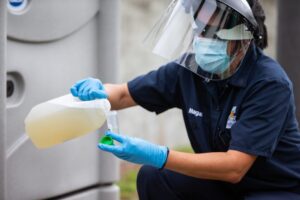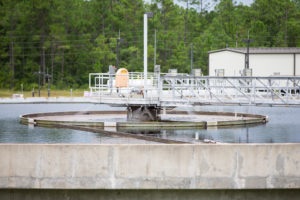 Orange County continues to remain diligent as it monitors wastewater for upticks and downswings in COVID-19 rates, including any of the virus’s new variants. Since May 2021, the County has been actively participating in the Centers for Disease Control Health and Human Services National Wastewater Surveillance System. By monitoring wastewater from the county’s water reclamation facilities for concentrations of SARS-CoV-2 RNA, officials have been able to determine where to put testing and vaccination sites and where to allocate resources.
Orange County continues to remain diligent as it monitors wastewater for upticks and downswings in COVID-19 rates, including any of the virus’s new variants. Since May 2021, the County has been actively participating in the Centers for Disease Control Health and Human Services National Wastewater Surveillance System. By monitoring wastewater from the county’s water reclamation facilities for concentrations of SARS-CoV-2 RNA, officials have been able to determine where to put testing and vaccination sites and where to allocate resources.
Orange County Utilities is currently testing wastewater for the Alpha, Beta, Gamma, Delta, Epsilon, Kappa, Lambda, Mu, and Omicron variants.
“We’re proud to be participating in this national surveillance system,” said Ed Torres, Director, Orange County Utilities. “This testing is a safe, non-invasive way for us to monitor the different variants and their impact on our community.”
Wastewater is used water that is discharged away from homes and commercial businesses into sewer systems. In Orange County, wastewater travels through a sewer system consisting of a maze of underground pipes and eventually winds up at one of the County’s three water reclamation facilities — the Southern Water Reclamation Facility, Eastern Water Reclamation Facility, and Northwestern Water Reclamation Facility. Collectively, these facilities serve approximately 870,000 people.
“Anyone infected with COVID-19 — whether they’re asymptomatic or symptomatic — will shed viral remnants into their wastewater for approximately 21 days after contracting the virus,” explained Torres. “These remnants are broken down pieces of the virus, meaning they’re non-contagious and pose no threat to our customers.”
Once the wastewater is collected, small samples (250 ml) are taken from each facility throughout the day and sent off to a lab two times a week. At the lab, scientists measure for any remnant levels of the virus per liter of water. Remnants are non-infectious RNA fragments that are non-viable, which means the virus cannot be spread through the wastewater. The data collected has been invaluable in helping the County better understand the spread of the virus across the region.
“This data helps predict infections four to 10 days before we see changes in our community’s caseload, allowing county leadership and medical professionals to adjust public health resources accordingly,” added Torres. “Because both symptomatic and asymptomatic carriers of the virus shed remnants in their waste, this data provides an accurate picture of how the virus is spreading in our community regardless of the number of people tested.”
 One misconception about wastewater monitoring is that it invades people’s privacy. But, in fact, monitoring wastewater in reclamation facilities enables the County to monitor levels in specific regions of the County, not in specific homes, making the system both private and safe.
One misconception about wastewater monitoring is that it invades people’s privacy. But, in fact, monitoring wastewater in reclamation facilities enables the County to monitor levels in specific regions of the County, not in specific homes, making the system both private and safe.
Orange County Utilities has made its data publicly available through an online dashboard. The data is updated once a week and gives users a snapshot of the testing results and process. Visit the dashboard here.


